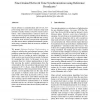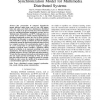152 search results - page 6 / 31 » Using Simple Diffusion to Synchronize the Clocks in a Distri... |
OSDI
2002
ACM
14 years 7 months ago
2002
ACM
Recent advances in miniaturization and low-cost, lowpower design have led to active research in large-scale networks of small, wireless, low-power sensors and actuators. Time sync...
ICCD
1992
IEEE
13 years 11 months ago
1992
IEEE
Asynchronous or self-timed systems that do not rely on a global clock to keep system components synchronized can offer significant advantages over traditional clocked circuits in ...
ICC
2007
IEEE
14 years 1 months ago
2007
IEEE
Single-frequency simulcast networks use two or more Radio Base Stations (RBS) to transmit simultaneously the same signal on the same radio channel over the service area. To ens...
ICDCSW
2002
IEEE
14 years 15 days ago
2002
IEEE
Time-driven Key Sequencing (TKS) is a key management technique that synchronizes the session key used by a set of communicating principals based on time of day. This relatively lo...
JMM2
2008
13 years 7 months ago
2008
The preservation of temporal dependencies among different media data, such as text, still images, video and audio, and which have simultaneous distributed sources as origin, is an ...


